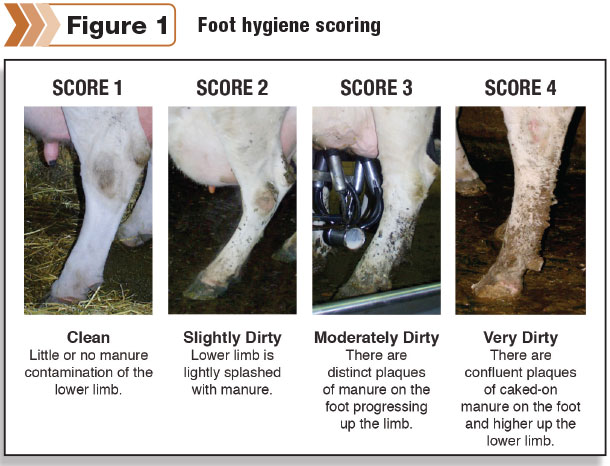As the seasons change and cooler temperatures arrive, now is a great time to evaluate the current state of hoof health in your herd. Hoof health records, maintained throughout the year, can be a tremendous resource to establish baseline levels for both infectious and non-infectious claw lesions.
Depending on trimming frequency, they may also help identify seasonal trends. By understanding baseline disease incidence, seasonal trends and peak infectious lesion pressure, you can match the intensity of your footbath program (for disease prevention) to the needs of your individual herd.
The most prevalent infectious claw disease in dairy cattle is digital dermatitis (DD). If left unchecked, DD can cause painful skin lesions that often lead to lameness, decreased milk production and increased reproductive failure.
To combat DD, many producers rely on footbath programs. Footbaths are a lameness prevention tool designed to help reduce the progression of subclinical and chronic cases of DD into acute, clinical lesions. Footbaths should not be used or expected to treat clinical cases of DD. Topical treatment (on an individual animal basis) is the only therapy known to decrease the number of active DD lesions.
Early topical treatment with effective antimicrobials helps reduce the duration of the infectious period for DD lesions and increases cure rates. Consequences of delayed treatment include increased lesion recurrence (chronic lesion development) and transmission of DD to healthy animals.
In order to effectively manage infectious claw lesions (including DD), it is important to consider the environment in which the foot is housed. Throughout the hot summer months, dairies typically use misters and soakers to help dissipate heat from cows and prevent production losses due to heat stress.
However, use of misters and soakers for heat abatement often results in increased exposure of the hoof and surrounding skin to extended periods in a wet environment (water or manure slurry) where bacteria may be present. When hydrated feet and skin are exposed to bacteria in a moisture-rich environment – compounded by either chemical or physical trauma to the skin – this represents ideal conditions for DD to develop and spread throughout the herd.
What is digital dermatitis?
Digital dermatitis develops from multiple risk factors as a result of a weakening of the skin barrier by mechanical or chemical irritation, wet environmental conditions and immune depression. The infection includes a strong bacterial component, primarily Treponema spp., which can exist in both active and cystic (dormant) forms. Typical progression of the disease includes early, acute (ulcerative) M2 and chronic stages. Once DD has infected the animal, it is difficult to eliminate. It is important, therefore, to focus on minimizing new infections and decreasing the duration of acute (ulcerative) M2 cases.

Footbath management essentials
Effective footbath programs hinge on three key factors: foot hygiene, proper footbath design and effective footbath management.
Foot hygiene
- Foot and leg hygiene should be used to determine footbath frequency. Dirtier cows will require more frequent footbathing (Figure 1).
- Footbaths should be used as recommended based on hygiene scores and on consecutive days when used to increase treatment efficacy. On non-footbath days, keep hygiene in check with a soap bath (1 quart of soap to 25 gallons of water) or allow cows to bypass the footbath.
Design
- Ideal footbath length is 10 to 12 feet. A minimum length of 10 feet ensures that both rear feet receive at least two immersions in solution.
- Ideal width for a footbath is 1.6 to 2 feet. This is wide enough to ensure that cows can walk through comfortably while minimizing the amount of footbath solution – and hence the amount of chemical – needed to charge the footbath.
- Step-in height should be 10 inches. It has been proven that cows have no problem with a curb of this height. The higher step-in height increases the number of foot immersions in the bath.
- The minimum solution depth should be 4 inches. This helps ensure full immersion of the hoof in solution.
Management
- Footbaths should be located on a level surface in an area regularly traveled by cattle.
- Cows should be able to bypass permanent footbaths on days when they are not being used.
- Animals should enter a clean, dry area after passing through the footbath.
- A common industry standard is to change footbath solution after every 100 to 300 cows or 1 liter (roughly 1 quart) of footbath solution per head. However, frequency will vary depending on cow cleanliness, rate the solution is fouled by manure or urine, type of disinfectant or chemical concentration used, weather conditions and trends established from hoof health records.
- Remember to alternate times for replenishing footbaths with fresh solution so each group of cows has access to fresh solution.
- Thoroughly drain the footbath and rinse it with water before mixing a new batch of solution.
Prevention through nutrition
The bacteria that are thought to cause DD have the ability to penetrate deeply into the skin, so building a more resilient barrier to the bacteria is key to disease prevention. Improved trace mineral nutrition within a well-fortified diet has been shown to help cattle build stronger skin integrity and a more empowered immune system.
Trace mineral nutrition also plays a critical role in building and maintaining strong, healthy feet. Research has shown that feeding a combination of trace minerals (zinc, manganese, copper and cobalt) in a highly available, complexed form helps decrease both the incidence and severity of common claw lesions. PD

-
Jeff Defrain
- Research Nutritionist
- Zinpro Corporation
- Email Jeff DeFrain






